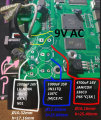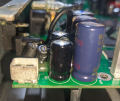Hello, I am trying to fix my multi-effects guitar pedal Line6 M13 Stompbox Modeler, it does some weird constant noise when I use it, through the amp. I disassembled it and noticed a few capacitors "blown", right at the input of the circuit. By the way, it uses a 9V AC (not DC!) 2A adapter.
I unsoldered 5 caps at the input, tested them, apparently all broken (good news), and since these are tagged I could find out the specs and replace them. I just soldered them, all fine. Now... before even trying to connect it and turn it on, I would like to know what these 2 components are, the pink ones:

I would say they are coils, and the DMM gives me in both about 0.4-0.3 Ohm, so yeah, looks like the short circuit of a coil, but since these are not tagged, I can't replace them and can't know their specs.
Notice all the damaged caps are at the beginning, and because these 2 components are at the beginning too, I was afraid they would be broken too.
Here are some more pictures before removing the caps:


Also, parallel to this, the AC adapter is broken too, it's supposed to be a 220V AV to 9V AC 2A (18W), but the reading with my DMM gives 11.2V AC. I opened it and it's just a transformer, no electronic circuit at all. I tested it for shortcircuit and there it was, the output was shorted. I didn't understand then that reading.
I already bought another one, but my question is... what can happen to a transformer (well, in this case it's 100% a short in the output) to give you 11.2V when it was supposed to give 9V?
I haven't thought about it much, but I would say that if you short at some point the secondary coil, the reading would be 0V AC, because 0 Ohm should only give 0V (well, coils are a short but they are generating an EM field inside and I know they don't read 0V). That or AC is messing with me.
I unsoldered 5 caps at the input, tested them, apparently all broken (good news), and since these are tagged I could find out the specs and replace them. I just soldered them, all fine. Now... before even trying to connect it and turn it on, I would like to know what these 2 components are, the pink ones:

I would say they are coils, and the DMM gives me in both about 0.4-0.3 Ohm, so yeah, looks like the short circuit of a coil, but since these are not tagged, I can't replace them and can't know their specs.
Notice all the damaged caps are at the beginning, and because these 2 components are at the beginning too, I was afraid they would be broken too.
Here are some more pictures before removing the caps:


Also, parallel to this, the AC adapter is broken too, it's supposed to be a 220V AV to 9V AC 2A (18W), but the reading with my DMM gives 11.2V AC. I opened it and it's just a transformer, no electronic circuit at all. I tested it for shortcircuit and there it was, the output was shorted. I didn't understand then that reading.
I already bought another one, but my question is... what can happen to a transformer (well, in this case it's 100% a short in the output) to give you 11.2V when it was supposed to give 9V?
I haven't thought about it much, but I would say that if you short at some point the secondary coil, the reading would be 0V AC, because 0 Ohm should only give 0V (well, coils are a short but they are generating an EM field inside and I know they don't read 0V). That or AC is messing with me.






